Page 1 of 3
90 down 90 to go
Posted: Sun Jan 22, 2017 6:17 pm
by John Clarke
Early last year I took the KT008 for a cold winter trek round the garden in the snow, avoiding any Comet/Sherman rear actions, pictures been taken, all was going well. Being stopped only by early wear and tear, a bit too realistic for my liking. A track broke. (shelf queens need not worry)
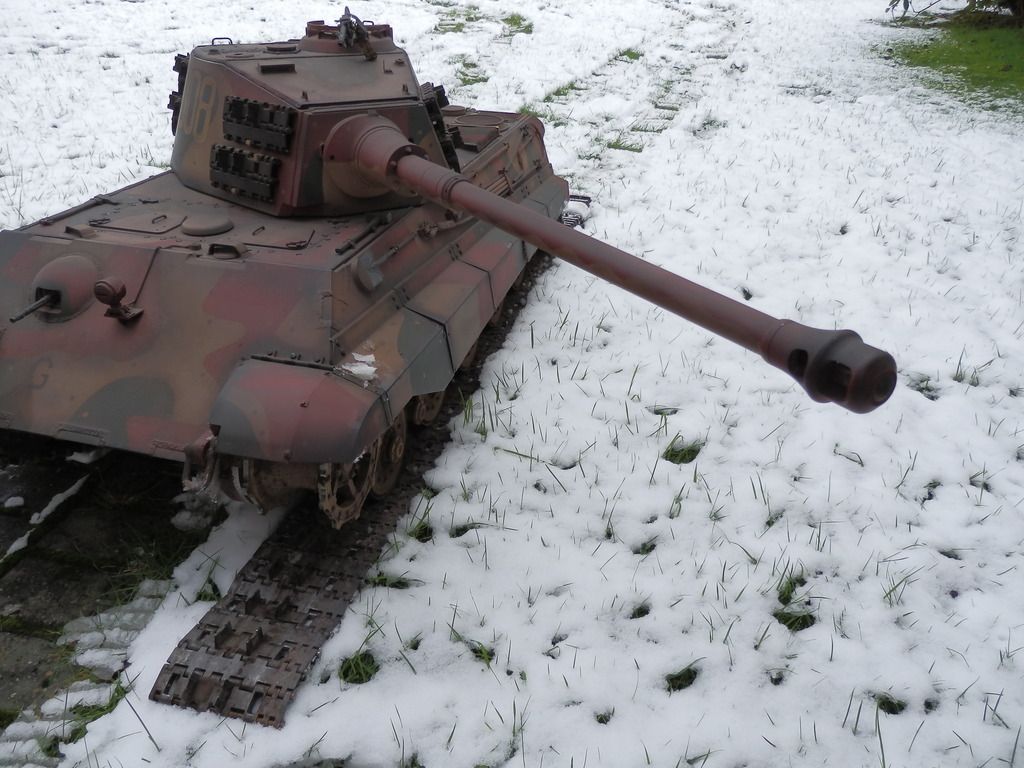
The tank does not travel well with one track, the other was easily removed and the tank pushed back to storage. The plan was to inspect and repair, put on hold for warmer weather. Time past. warm weather too.
Needing to have a break from building an Armortek C8. Began the track job.
Other than the actual broken track piece, four other pieces were also found damaged along both track lengths, with minor thinning to three other pieces. The five broken tracks pieces shown here show parts broken away or cracked.
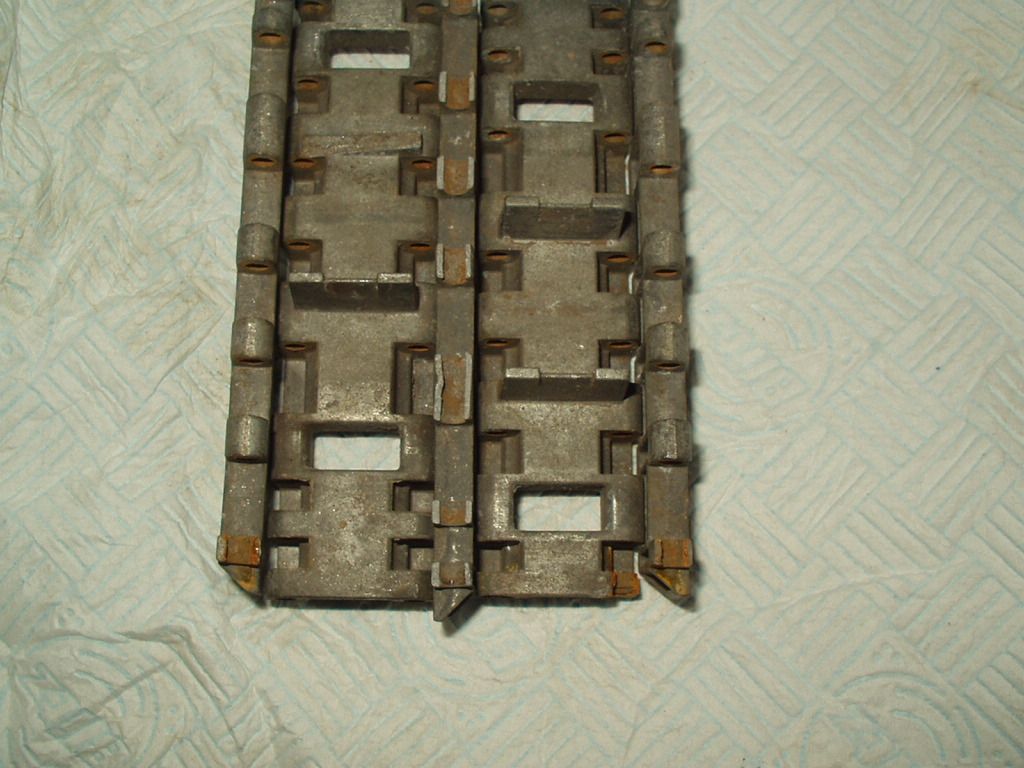
It's a long winded job, first, stripped down, wire brushed the pins, check straightness, paint with rust converter, grease and rebuild using new stainless split pins.
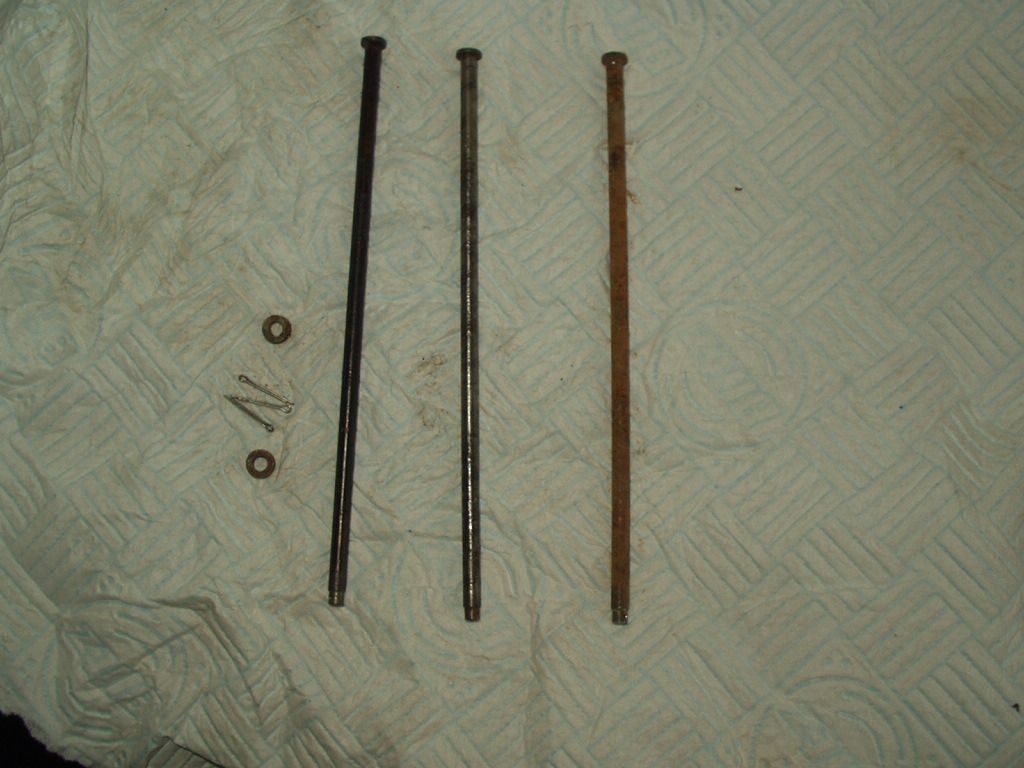
Now half way through, 90 to go.
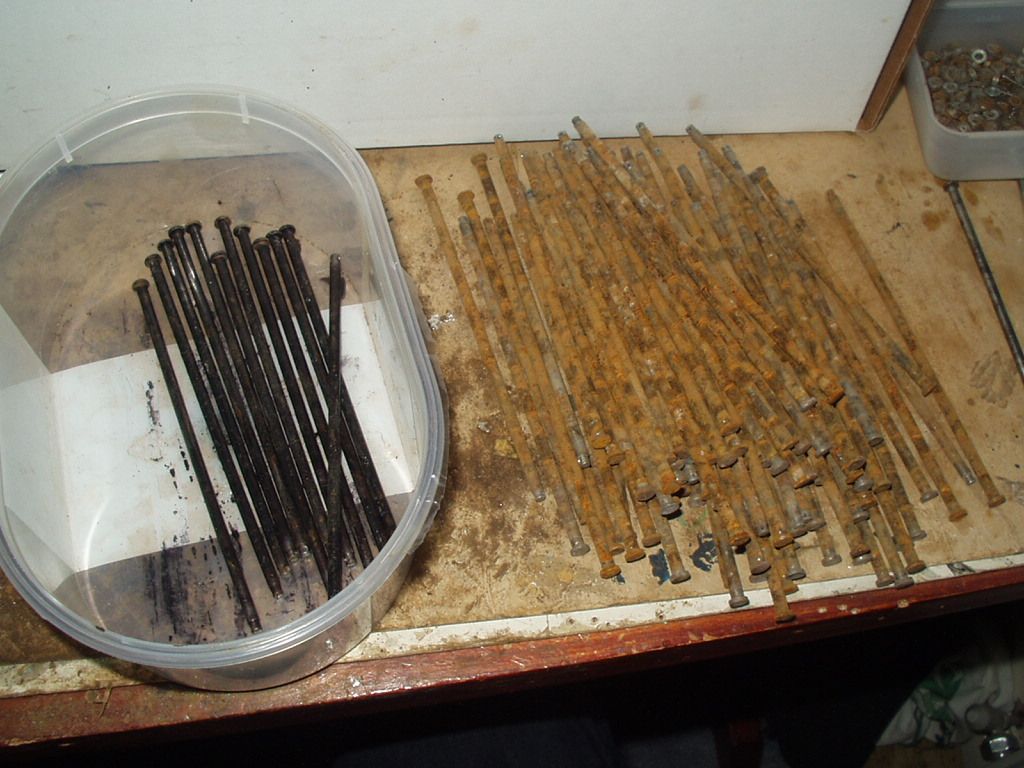
The 2009 model needs eight new pieces of track fitting to return to service. Four track pins were found slightly bent.
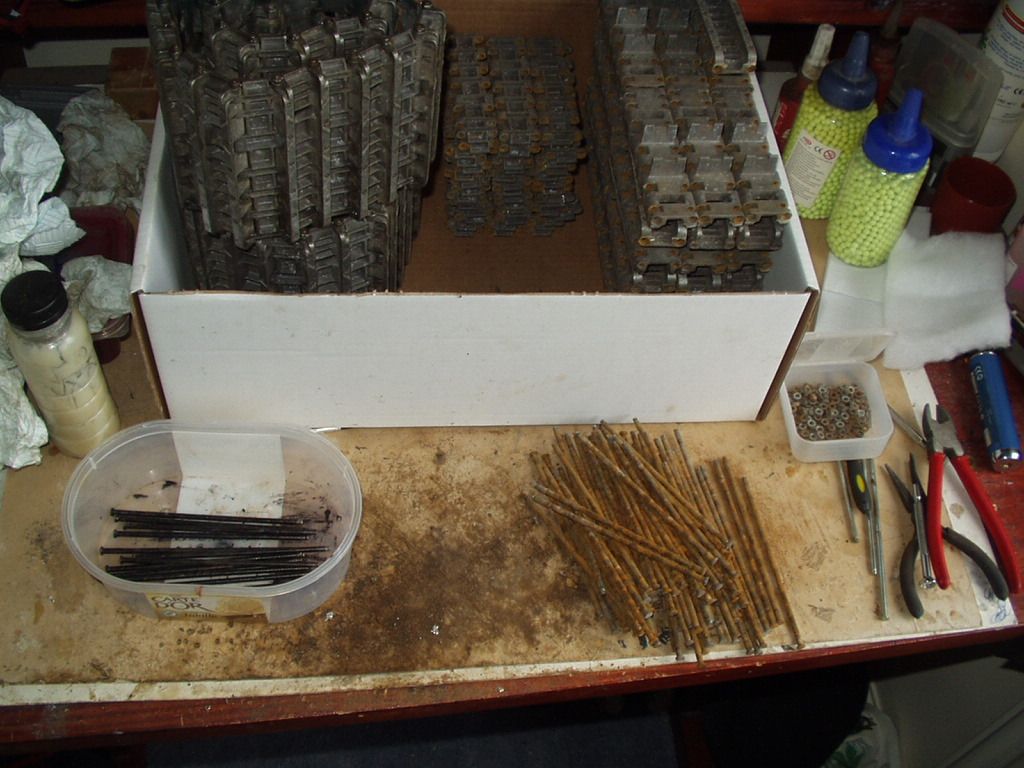
Spare track and pins brought with the model will ensure KT008 continues to prowl for many years to come.
If your tank is used in the great out doors, it might be prudent to give the tracks a check over and lubricate from time to time.
Re: 90 down 90 to go
Posted: Sun Jan 22, 2017 6:39 pm
by Peter Silcock
John just to save you a load of scrubbing treating etc try buying a kilo of acetic acid granules £3 per kilo from ebay. Mix in a ratio of 1 part to 6 parts warm water and put all the pins in - you can use a plastic container. After 20 mins ish it will look as though nothing has happened but you will find that the rust will literally wash off. So easy and you can pour the stuff down the drain ok - it is used in cooking so safe. A kilo will last for ages . I use it all the time for rust removal now.
Re: 90 down 90 to go
Posted: Sun Jan 22, 2017 8:33 pm
by John Clarke
Hi Peter
Thanks for the advice.
Sounds like good plan, the rust converter used on the first 90 does coat the pins with a little protection and might be applied after the wash, we'll see. Certainly the chemical wash would take some of the pain away, I use a small modellers grinder with a wire brush attachment to clean up 10 pins at a time. (All I can cope with at one go)
Re: 90 down 90 to go
Posted: Sun Jan 22, 2017 9:50 pm
by simon_manning
hi john, stainless steel track pins, i had two sets made once upon a time, reasonable cost, no rust, easy to maintain, still in my tigers today, regards simon manning.
Re: 90 down 90 to go
Posted: Sun Jan 22, 2017 10:02 pm
by John Clarke
Hi Peter
Had quick look on ebay, acetic acid solution found, but no granules at the moment. That sent me thinking about ascorbic acid, No lemon juice, pancake day a little way off, but there's always Sarson's vinegar.
So dunked a couple of pins in a tub and let it do it's thing. It works a little slower than than you describe acetic acid. But the results left over night should be about the same after a wipe with a kitchen scourer.
Hi Simon
In preparation for the job picked up 200 stainless steel split pins for a fiver on ebay 1mm x 10mm not as long as standard Armortek length but capable to do the job, cheers
Thanks for the inspiration
Re: 90 down 90 to go
Posted: Sun Jan 22, 2017 10:18 pm
by Adrian Harris
I'm going through a similar process with the Sherman BARV tracks, as I'd noticed that some of the pins were rotating in the end connectors rather than within the links.
I found that Jenolite removed almost all of the muck and rust from the pins but, because the Sherman pins are plated, any signs of rust show that the plating has been compromised, so I have bought a complete new set from Gill and have binned the old pins.
I think the pins might have been greased, as all but two came out without the need for significant force and even the two reluctant ones cam free with a little heat.
Could the broken links be due to the swelling effect of the rust ?
When I get round to rebuilding the track, I'm going to take the advice in the Knowledge base and coat the track pins and holes with ROCOL dry PTFE lubricant, to try and keep the pins moving in the links.
Adrian.
Re: 90 down 90 to go
Posted: Sun Jan 22, 2017 11:11 pm
by John Clarke
After two hours in the vinegar the results are very good. Overnight should do the trick, though stainless pins sound like best option, but till then, a coating and grease will have to do.
I'm not's sure about rust expansion but the rust will surely act as an active abrasive.
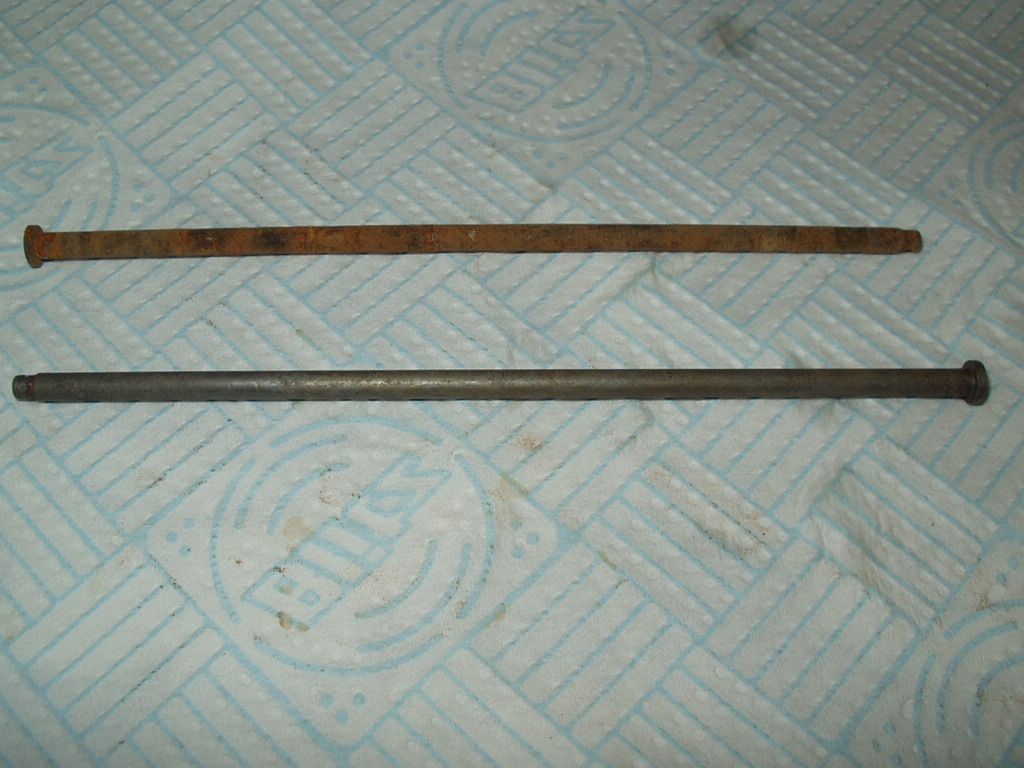
Re: 90 down 90 to go
Posted: Mon Jan 23, 2017 8:51 am
by Peter Silcock
John sorry misled you there - creeping old age! I had previously tried acetic acid but what I have been using recently is citric acid. Bought from elixirgardens on ebay but there are lots of suppliers. Vinegar does work but obviously a lot more diluted than my concoction. Sounds as though you have found a way forward though!
Re: 90 down 90 to go
Posted: Mon Jan 23, 2017 12:58 pm
by John Clarke
No worries, should have thought of chemical action and saved a lot of grief.. Soaked the pins over night in vinager. Use a scouring pad on each pin in fresh water, all done with in an hour.
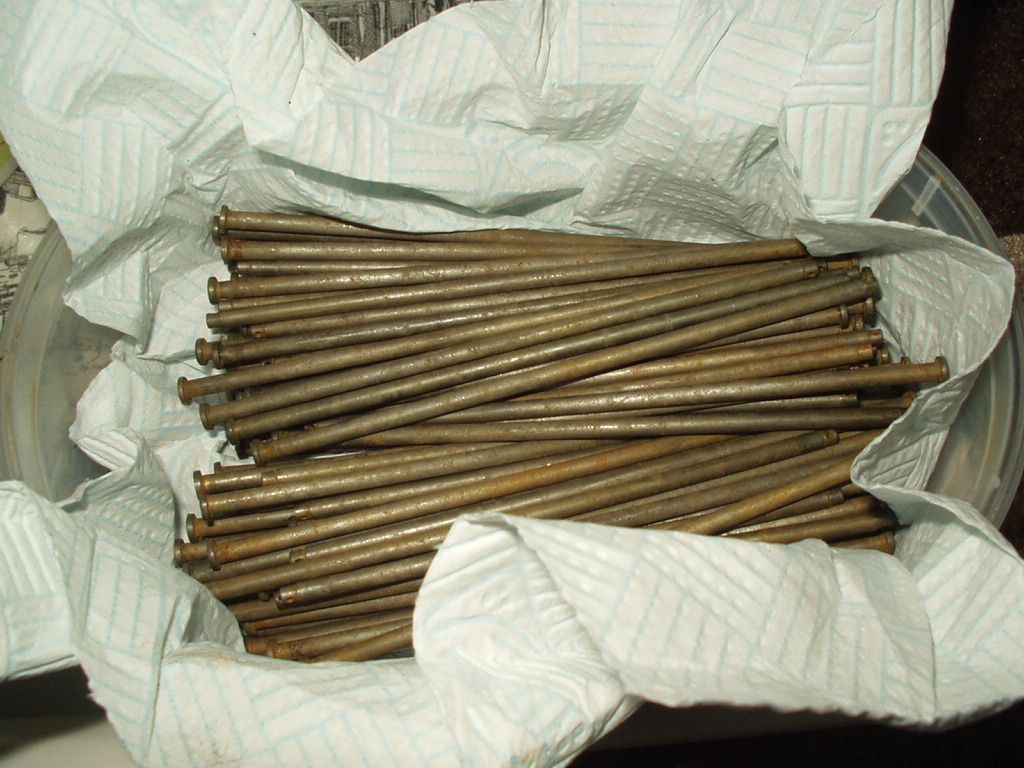
Now they just need a coating of cure rust which turns them black, greased up and put them all back together. At the end of the day good exercise in model tank maintenance.
I'll be fitting them when the warmer weather comes along. Lets hope summer good this year
Re: 90 down 90 to go
Posted: Mon Jan 23, 2017 4:41 pm
by Gerhard Michel
Adrian Harris wrote:...............
Could the broken links be due to the swelling effect of the rust ?
...........
Adrian.
Hello Adrian,
may be, but I don't think so. The last years I saw some broken links at armortek models in action (especially Panther / Jagdpanther, Tiger I, and King Tiger), also together with clean and rust-free bolts.
Maybe the faithfully large drilled hole in the link makes the remaining material too thin for the load. What fits a steel track link (original) may not fit an aluminium track link (model). Other 1/6 scale manufacturers like Bigtanks use thicker track links combined with thinner bolts. Not very nice to view, but rather durable. Therefore my solution are steel track links at all my models; preferably combined with brass oder bronze bolts, for they are faithfully shaped
and durable!

Re: 90 down 90 to go
Posted: Mon Jan 23, 2017 6:13 pm
by Stephen White
Adrian, your suggestion that rust is at the root of this seems wise. If track links are rusted, it's axiomatic that they will have higher friction resistance and will therefore impose a shearing strain on the track webs, particularly as appears to be the case here, at low temperatures. The solution isn't a thicker material (which would not be true to scale) or steel, which would have a significant cost and weight disadvantage, but to maintain the tracks to avoid rust.
The pins can be de-greased, cleaned, etch primed and, if desired, coated in a dry lubricant. That will go a long way to avoiding rust. This seems a reasonable precaution for running the models in rough terrain, which they are perfectly capable of doing. Leaving the track pins untreated presumably increases the risk of rust and therefore the maintenance requirements.
The Knowledge Base advice is:
Users tend to run their Armortek models in short, intense sessions and then store them for protracted periods, possibly not in a temperature controlled environment. Operation on rough terrain exposes the model to moisture and particles, such as sand and dust, which can get into the drive train and cause wear, particularly to gears and bearings.
The greatest threats are therefore corrosion and wear due to contamination.
Dry lubricants can protect against corrosion and reduce wear. Wet lubricants, such as oils and greases, attract particles and increase wear. The strong advice is to avoid using wet lubricants - period.
A number of dry, molybdenum based lubricants are available (such as Rocol Oxylube).
The real track killer is the stone in the sprocket. The only track failures I've seen have been the result of a stone becoming jammed between the track and the sprocket and imparting a twisting force to the track which, if sufficient power is applied, will snap a link.
The same thing can and does happen to full size tanks and drivers know to listen for the tell-tale sounds. Newcastle discovered this in the early seventies when a certain cavalry regiment exercised the Freedom of the City, which involved a parade with Chieftains down Grey Street, which was cobbled at the time. The drivers became quite adept at discharging the cobbles sideways. There were lots of plate glass windows on the shops in Grey Street...... Luckily, this only seemed to happen during the rehearsal, which took place in the early hours.
Regards
Stephen
Re: 90 down 90 to go
Posted: Tue Jan 24, 2017 1:30 am
by Gerhard Michel
Hello Stephen,
I agree that thicker links and thinner steel pins are not satisfying for an Armortek model owner, because this is not true to scale. However non-rusting materials like brass or bronze for the pins could be a good solution, also due to their self-lubricating nature. Steel track links on models have two sides: they are indeed nearly non-destructable, but yes, I have to accept the costs and the weight and the fact, that then other -probably more expensive- parts of the drive train can be damaged, see down below!
And I agree that stones, deep sand and so on can be hazardous to the drive train. But please remember that models of this shape in my eyes are nevertheless no more simple toys but little real tanks and should be able to be treated as real tanks, and nearly no terrain must be too much challenging for them.

Okay, such a treatment can result in some damage, when the mechanical stress is too high. This can happen to a full size tank (I was tank driver with about 2,500 tank miles) and to a model tank, and I think the driver has to accept that and to manage such situations. Here a broken Tiger I link:

and here a much more severe damage using steel track links: 2 broken suspension arms! Under those bad conditions aluminium track links could have been the better solution, because they were broken first. Not ever steel track links are the best solution, but they can prevent some minor damages.
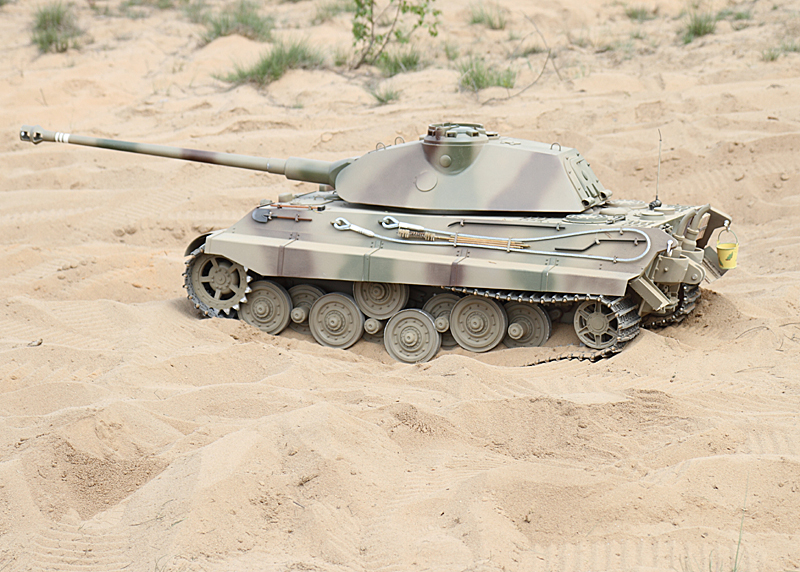
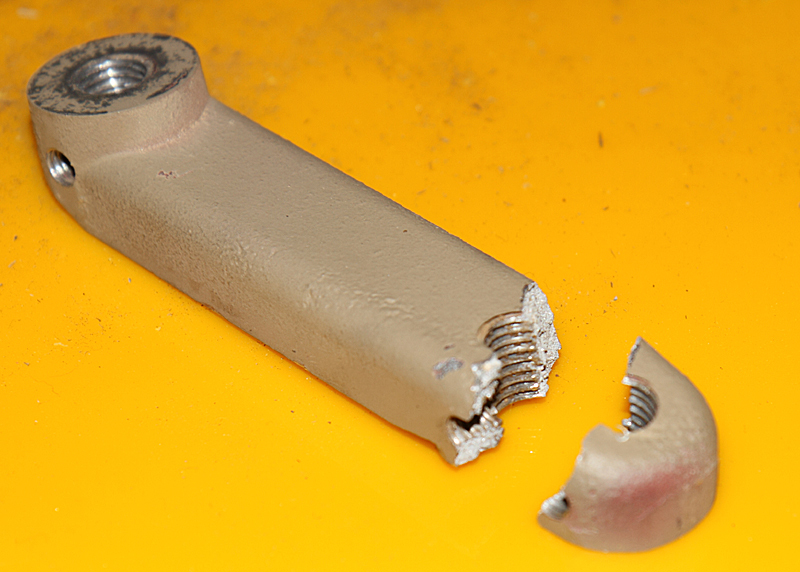
Re: 90 down 90 to go
Posted: Tue Jan 24, 2017 4:05 pm
by dennypatterson
Re: 90 down 90 to go
Posted: Tue Jan 24, 2017 4:30 pm
by Gerhard Michel
Well, after such an operation any rust is away from the whole drive train (but some painting too)........

Re: 90 down 90 to go
Posted: Thu Jan 26, 2017 7:38 pm
by Mark Heaps
Gerhard Michel wrote:But please remember that models of this shape in my eyes are nevertheless no more simple toys but little real tanks and should be able to be treated as real tanks, and nearly no terrain must be too much challenging for them.

I totally agree
Gerhard Michel wrote:Okay, such a treatment can result in some damage, when the mechanical stress is too high. This can happen to a full size tank (I was tank driver with about 2,500 tank miles) and to a model tank, and I think the driver has to accept that and to manage such situations.
I also totally agree.
Unfortunately we can make RC models do manouvres that the real vehicle just was not capable of. Some examples
1) full forward to full reverse ( reverse speed faster than on the real vehicle ) almost instantaneous. The only limits being speed of response of the electronics and inertia due to the weight of the model. Lot of stress on the whole running gear.
2) Even worse, going from full speed forward to a "neutral" turn ie one track running forward, the other running backwards. Even more stress.
3) A RC model of a FV432 if using two motors, one for each track, could do a neutral turn. The real one can´t, the gearbox is not capable of it. Challenger 1 and Challenger 2 can only do it when stopped and in neutral gear, and the driver would make sure the ground is suitable for doing so.
My ideal would be a "digital gearbox" or programmable circuit that shapes the servo signals from the transmitter before they reach the motors.
With the correct "mapping" for the vehicle ( acceleration rate, braking rate, engine rpm range, number of forward / reverse gears, speed in each gear at a specified engine rpm ) it should be possible to achieve the following.
1) More realistic acceleration and braking
2) No manouvres that the original vehicle was incapable of doing
3) Easier, more precise control at slow speeds
4) Realistic maximum reverse speed.
Perfect would be if it had a third output to the sound card and smoker unit for the engine speed, ie rpm going up when accelerating and then dropping down when the next gear is selected. Same when braking, engine rpms reducing and then shooting up as the next lower gear is engaged.
If the model is then "driven" realistically, I am sure that the armortek track would be quite sufficient to cope with all but the most extreme conditions.
Attached is a table showing how I envisage such a "digital gearbox" could operate.














